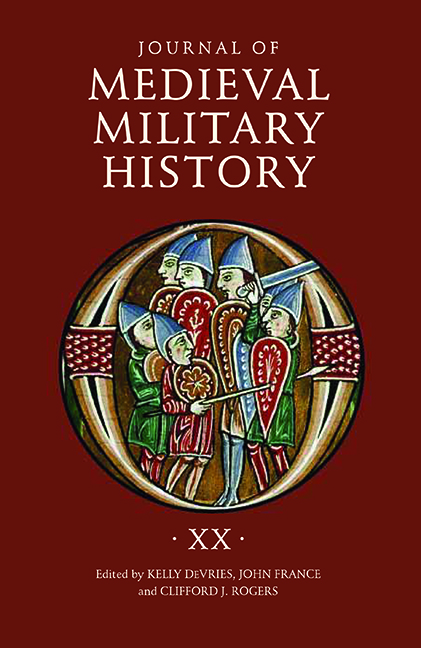Book contents
- Frontmatter
- Contents
- List of Illustrations
- 1 De velitatione bellica and the Georgian Art of War During the Reign of David IV
- 2 The Afterlife of the Medieval Christian Warrior
- 3 More Accurate Than You Think: Re-evaluating Medieval Warfare in Film
- 4 Raising the Medieval Trebuchet: Assembly Method and the Standing of a Half-scale Machine
- 5 Cum Socio Eiusdem: Military Recruitment in the Armies of Edward I Among the Sub-Gentry
- 6 Two Walls of Protection: Queen Elionor of Sicily and Bishop Berenguer de Cruïlles of Gerona During the 1359 Naval Campaigns of The War of the Two Pedros
- 7 The Lancegay and Associated Weapons
- 8 “I intend to give him battle.” Battle-Seeking in a Civil War Context: Toro (1476)
- 9 Discovery of an Early Sixteenth-Century Battle Plan from the Archdiocesan Archive in Ljubljana
- List of Contributors
- Journal of Medieval Military History 1477-545X
8 - “I intend to give him battle.” Battle-Seeking in a Civil War Context: Toro (1476)
Published online by Cambridge University Press: 07 October 2022
- Frontmatter
- Contents
- List of Illustrations
- 1 De velitatione bellica and the Georgian Art of War During the Reign of David IV
- 2 The Afterlife of the Medieval Christian Warrior
- 3 More Accurate Than You Think: Re-evaluating Medieval Warfare in Film
- 4 Raising the Medieval Trebuchet: Assembly Method and the Standing of a Half-scale Machine
- 5 Cum Socio Eiusdem: Military Recruitment in the Armies of Edward I Among the Sub-Gentry
- 6 Two Walls of Protection: Queen Elionor of Sicily and Bishop Berenguer de Cruïlles of Gerona During the 1359 Naval Campaigns of The War of the Two Pedros
- 7 The Lancegay and Associated Weapons
- 8 “I intend to give him battle.” Battle-Seeking in a Civil War Context: Toro (1476)
- 9 Discovery of an Early Sixteenth-Century Battle Plan from the Archdiocesan Archive in Ljubljana
- List of Contributors
- Journal of Medieval Military History 1477-545X
Summary
On March 1, 1476, Ferdinand the Catholic faced Afonso V of Portugal in the battle of Toro. Despite the fact that the battle had a disputed result, it was a strategic victory for the future Catholic Monarchs. This paper will analyze the development of the early stages of the War of Castilian Succession and the military events leading to the pitched battle, focusing on Ferdinand's battle-seeking strategy. Toro's example will serve to illuminate the role of battle-seeking strategies in civil war contexts, their political and propagandistic value, and their consequences.
Afonso V of Portugal invaded Castile in May 1475, starting the War of Castilian Succession, which lasted until 1479. The conflict was, in fact, a civil war, that was virtually settled with the last light of day on 1 March 1476, in the fields that spread out in front of the town of Toro. Although the battle of Toro resulted in a disputed victory, the day turned out to be a strategic triumph that tipped the scales of war in favor of the Catholic Monarchs. In the end, Toro was a battle that resolved the political issue of the war, making many of those who had supported the Portuguese pretender change sides and securing the throne for Isabella. The hope of such a decisive strategic victory is exactly why Ferdinand had very eagerly sought a full-scale battle in the weeks leading up to the combat.
One might well ask how a battle without a clear tactical winner managed to turn into a strategic success. That, however, makes it necessary to first answer other more far-reaching questions: what was the role of battle in internal wars? Did battle take on more importance and symbolism in civil war than in other types of conflict, stimulating commanders to actively seek a decisive clash?
Since the beginning of the twenty-first century, several of the most renowned medieval military historians have debated battle-seeking or battle-avoidance as a key element in the thought and practice of medieval military leaders, attempting to rethink what is known as the Gillingham paradigm. The theory put forward by John Gillingham (building on R. C. Smail's work) asserts that medieval military leaders – following Vegetius – would rarely accept battle, and then only if they felt sure of gaining a victory or had no other option.
- Type
- Chapter
- Information
- Journal of Medieval Military HistoryVolume XX, pp. 185 - 202Publisher: Boydell & BrewerPrint publication year: 2022
- 1
- Cited by



